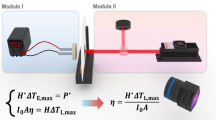Play all audios:

ABSTRACT THE transmission of ultra-violet light by glass in the region of 3000 A. has long been known to be reduced when the glass is exposed to light, and restored by heating to 250–300° C.
Slow restoration also takes place when the glass is kept in the dark. SIMILAR CONTENT BEING VIEWED BY OTHERS A GENERAL METHODOLOGY TO MEASURE THE LIGHT-TO-HEAT CONVERSION EFFICIENCY OF
SOLID MATERIALS Article Open access 17 May 2023 REVERSIBLE 3D OPTICAL DATA STORAGE AND INFORMATION ENCRYPTION IN PHOTO-MODULATED TRANSPARENT GLASS MEDIUM Article Open access 07 July 2021
CHROMATIC DISPERSION AND THERMAL COEFFICIENTS OF HYGROSCOPIC LIQUIDS: 5 GLYCOLS AND GLYCEROL Article Open access 13 December 2023 ARTICLE PDF AUTHOR INFORMATION AUTHORS AND AFFILIATIONS *
"Watch Hill”, The Ridings, Shotover, Oxford WILLIAM J. ARROL Authors * WILLIAM J. ARROL View author publications You can also search for this author inPubMed Google Scholar RIGHTS AND
PERMISSIONS Reprints and permissions ABOUT THIS ARTICLE CITE THIS ARTICLE ARROL, W. Change of Ultra-Violet Transparency of Glass with Temperature. _Nature_ 145, 861 (1940).
https://doi.org/10.1038/145861a0 Download citation * Issue Date: 01 June 1940 * DOI: https://doi.org/10.1038/145861a0 SHARE THIS ARTICLE Anyone you share the following link with will be able
to read this content: Get shareable link Sorry, a shareable link is not currently available for this article. Copy to clipboard Provided by the Springer Nature SharedIt content-sharing
initiative
